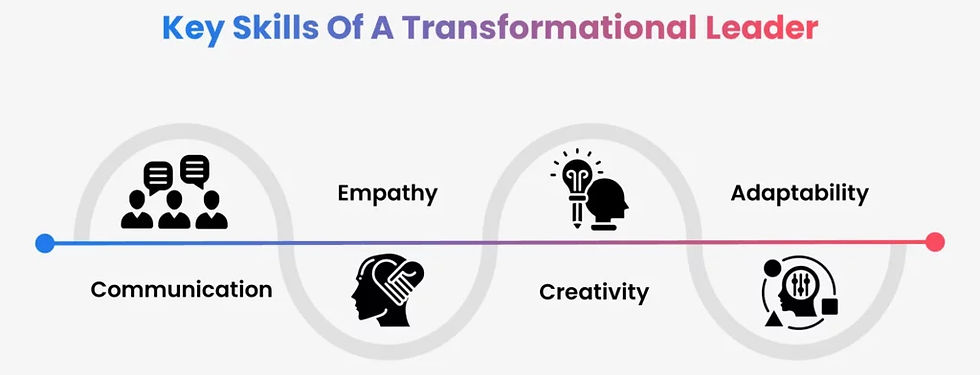From Vision to Impact: Becoming a Director of Transformation in Local Government
- truthaboutlocalgov
- Oct 19
- 7 min read
Transformation in local government is no longer a buzzword it’s a strategic imperative. Councils across the UK are navigating a perfect storm of financial constraints, rising service demand, workforce challenges, and shifting political priorities. Against this backdrop, the role of the Director of Transformation has emerged as one of the most critical leadership positions in the sector. This is not just about digital upgrades or organisational restructuring. True transformation is about reimagining how councils deliver public value aligning services with citizen needs, embedding innovation into everyday practice, and creating sustainable models for the future. It requires courage, clarity, and a deep understanding of both systems and people.
According to the Local Government Association, transformation programmes supported through their sector support offer have helped councils identify over £165 million in budget pressure solutions and deliver £1.6 million in direct savings in 2023–24 alone. Meanwhile, CIPFA reports that councils undergoing transformation with structured governance and financial assurance frameworks are better positioned to maintain resilience and avoid exceptional financial support.
Yet, stepping into this role can be daunting. What does success look like? What skills do you need to thrive? What do seasoned transformation leaders wish they’d known when they first took the reins? And what are the common missteps that can derail progress?

This blog draws on real-world insights, survey feedback from current Directors of Transformation, and strategic guidance to help aspiring leaders prepare for the journey ahead. Whether you're a Head of Service ready to take the next step, or a senior officer looking to pivot into transformation leadership, this is your roadmap to making a meaningful impact.
1. Core Skills You Need to Develop
Aspiring Directors of Transformation must develop a broad and strategic skillset to lead change effectively across complex council environments. According to the Local Government Association’s Transformation Capability Framework, successful transformation leaders consistently demonstrate the following capabilities:
Strategic Visioning
This involves co-creating a compelling vision for change that aligns with the council’s political priorities and community outcomes.
Example: A Director of Transformation in a metropolitan borough worked with elected members and residents to develop a five-year transformation roadmap focused on inclusive growth, digital access, and climate resilience. The vision was embedded into service plans and budget decisions.
Change Leadership
Transformation is as much about people as it is about process. Leaders must inspire and motivate teams through uncertainty.
Example: During a major restructure, a Director led weekly town halls, created a staff-led innovation group, and introduced coaching for managers to help them lead change confidently.
Data and Digital Literacy
Understanding how to leverage data and technology is essential for redesigning services and improving outcomes.
Example: A council used predictive analytics to identify households at risk of homelessness and redesigned its housing support service, reducing crisis interventions by 30 percent.

Governance and Risk Management
Embedding structured governance enables accountability and transparency while allowing innovation to flourish.
Example: A transformation programme introduced a new governance board with cross-party representation and citizen panels, ensuring oversight and community voice in decision-making.
Emotional Intelligence
Building trust, managing resistance, and fostering collaboration are vital.
Example: A Director noticed resistance from frontline staff during a digital rollout. By holding listening sessions and adjusting the implementation plan based on feedback, trust was rebuilt and adoption improved.
Outcome-Focused Thinking
Transformation must be rooted in improving outcomes for residents.
Example: Rather than focusing on internal efficiencies alone, a Director reframed a service redesign project around reducing child poverty, aligning KPIs with real-world impact and securing wider stakeholder support. A quote from the LGA Framework reinforces this point:
“Transformation professionals must understand the skills, knowledge and behaviours needed depending on the type of transformation being delivered.”
2. What Current Directors Wish They Knew on Day One
Stepping into the role of Director of Transformation is both exciting and daunting. Recent surveys, interviews, and lessons learned from transformation programmes across UK councils reveal a consistent set of reflections from those already in post. These insights offer valuable guidance for aspiring leaders.
“Finance is everything.”
Many Directors underestimated the complexity of aligning transformation with Medium-Term Financial Strategies. Early and ongoing engagement with finance teams is essential to ensure that transformation is not only visionary but also financially sustainable.
Example: One council’s transformation programme stalled when financial assumptions weren’t stress-tested against the budget cycle, leading to delays and reputational risk.
“Transformation must be financially assured from the outset. Without that, it’s just aspiration.” CIPFA

“Governance isn’t a barrier it’s your platform.”
Aidan Rave of the Good Governance Institute emphasises that governance should be seen as an enabler, not a constraint. “Don’t take your eye off the ball with governance… There needs to be a continuity of that line of sight in terms of governance right the way through.” Governance provides the structure for accountability, innovation, and resilience especially during periods of political or organisational change.
“Transformation is cultural, not just structural.”
Directors consistently reflect that they focused too heavily on systems and structures early on, and not enough on people and culture.
Example: Councils that invested in leadership development and staff engagement early saw stronger adoption and sustainability of change.
“Leadership isn’t a function, it’s a force multiplier… Structure alone doesn’t change how people behave.” West Midlands Employers
“You need allies.”
Transformation cannot be delivered in isolation. Building cross-departmental relationships and securing political sponsorship early makes a significant difference.
Example: One Director built a transformation steering group with representation from finance, HR, IT, and elected members, which became a trusted space for challenge and support.
“Transformation is a team sport. You need champions in every corner of the organisation.”
LGA Leadership Essentials

3. Common Pitfalls to Avoid
Transformation efforts fail 70 percent of the time globally, and in local government, the risks are amplified by financial pressures, political cycles, and complex stakeholder environments. Here are the most common pitfalls and how to avoid them with real examples from UK councils.
Lack of Clear Objectives
Pitfall: Without defined success metrics, transformation becomes fragmented and difficult to measure.
Case Study: At the London Borough of Hillingdon, a transformation programme lacked early clarity on outcomes. A zero-based budgeting approach was later introduced to align transformation with financial goals, helping the council deliver £54 million in savings over three years.
Strategy to Avoid:
Use a transformation prioritisation matrix (as adopted by Cumberland Council) to rank initiatives by impact and feasibility.
Define SMART objectives and link them to service KPIs and resident outcomes.
Top-Down Planning Without Engagement
Pitfall: Transformation designed in isolation from frontline staff leads to resistance and poor adoption.
Case Study: Dorset Council’s housing service embraced digital transformation by involving staff in co-design workshops. This built a culture of continuous improvement and improved service delivery post-reorganisation.
Strategy to Avoid:
Run staff-led innovation labs or listening sessions.
Use tools like the CIPD People Impact Tool to gather feedback and shape change collaboratively.

Underestimating Governance
Pitfall: Ignoring governance structures can derail progress and erode trust.
Case Study: Luton Borough Council worked with Local Partnerships to review its transformation governance framework. This included strengthening benefits management and using data to drive decisions, which improved performance in planning and street cleansing services.
Strategy to Avoid:
Establish a transformation board with cross-party and cross-departmental representation.
Embed governance into programme assurance and link it to scrutiny and audit functions.
Treating Transformation as a One-Off
Pitfall: Transformation must be embedded into the council’s operating rhythm not treated as a temporary project.
Case Study: Sefton Council’s 2024–2027 Transformation Programme is structured around three pillars: Everyday Excellence, Better Outcomes, and Setting Us Up to Succeed. This ensures transformation is part of business-as-usual, not a standalone initiative.
Strategy to Avoid:
Align transformation with corporate planning, workforce development, and budget cycles.
Create a transformation maturity model to track progress and embed continuous improvement.

4. Final Advice for Aspiring Directors
Invest in your leadership development
Emotional intelligence and strategic thinking are just as vital as technical skills. Transformation leaders must be able to navigate ambiguity, build trust, and influence across political and organisational boundaries.
Example: Councils like Warwickshire and Southwark have embedded leadership development into their transformation programmes, offering coaching and mentoring to senior officers to build resilience and strategic capability.
Build a coalition of support
Transformation is a team sport. You’ll need allies in finance, HR, IT, and among elected members. Building a cross-functional network early helps you navigate resistance and accelerate delivery.
Example: At Leeds City Council, the Director of Transformation established a cross-departmental steering group that met fortnightly to align priorities, troubleshoot delivery issues, and maintain momentum.
Stay resident-focused
Always ask: How does this improve outcomes for our communities? Transformation must be rooted in public value, not internal efficiency alone.
Example: North Tyneside Council redesigned its adult social care pathway by mapping the resident journey and co-producing solutions with service users, resulting in improved satisfaction and reduced waiting times.
Be bold, but grounded
Innovation must be balanced with accountability and financial realism. Councils operate in a high-stakes environment, and transformation must be both imaginative and deliverable.
Example: Barking and Dagenham’s Insight Hub used behavioural science and data modelling to redesign services, but every initiative was subject to rigorous cost-benefit analysis and political scrutiny.

Reflection for Current Directors of Transformation
Whether you’ve been in post for six months or six years, the role of Director of Transformation is one that constantly evolves. The pressures are real financial constraints, political shifts, workforce fatigue but so too is the opportunity to shape lasting change. This reflection is an invitation to pause, take stock, and reconnect with your purpose.
What have you learned that no one prepared you for?
Were there blind spots in governance, finance, or culture that only became clear with experience?
What do you now know about leading change that you wish you’d understood on day one?
Where have you made the greatest impact?
Which transformation initiatives have truly improved outcomes for residents?
What feedback from staff or communities has stayed with you?
What habits or mindsets have helped you thrive?
Have you built a coalition of support across departments and political leadership?
How have you maintained resilience and clarity in the face of complexity?
What would you tell your successor?
What advice would you offer to someone stepping into your shoes tomorrow?
What should they protect, challenge, or let go of?
What’s next?
Are you still leading transformation, or has it become business-as-usual?
What legacy do you want to leave and what do you need to do now to shape it?
Transformation is not a destination it’s a discipline. The most effective Directors are those who remain curious, humble, and committed to learning. Your experience is invaluable. Share it. Shape others. And keep leading change that matters.

Conclusion
Becoming a Director of Transformation is one of the most challenging and rewarding roles in local government. It demands strategic clarity, emotional intelligence, and the ability to lead through complexity. But with the right mindset, skills, and support, you can lead change that truly matters not just for your organisation, but for the communities you serve. Whether you're preparing to step into the role or already navigating its demands, transformation is never static. It’s a continuous journey of learning, adapting, and influencing. The most impactful leaders are those who remain curious, collaborative, and committed to public value.




